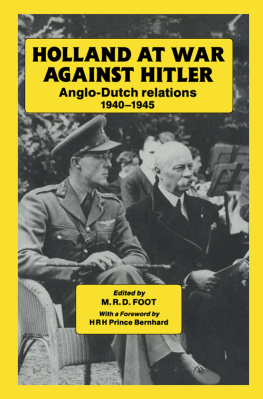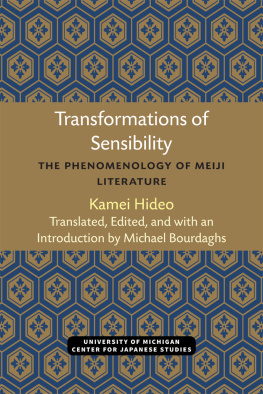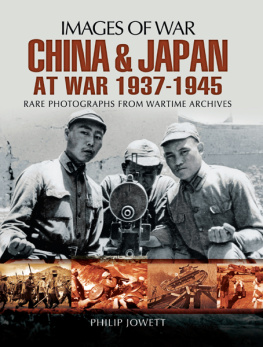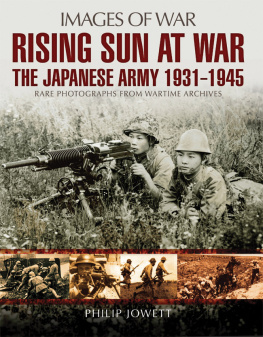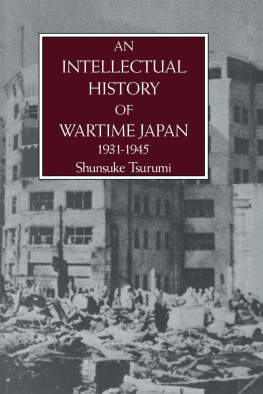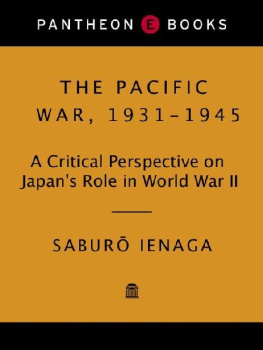2015 by the University Press of Kansas
All rights reserved
reprinted by permission of the publishers from The Food Problem of Evacuated Children in Wartime Japan, 19441945 , in Food and War in Mid-Twentieth-Century East Asia, edited by Katarzyna J. Cwiertka (Farnham: Ashgate, 2013 ), pp.. Copyright 2013 .
Published by the University Press of Kansas (Lawrence, Kansas 66045 ), which was organized by the Kansas Board of Regents and is operated and funded by Emporia State University, Fort Hays State University, Kansas State University, Pittsburg State University, the University of Kansas, and Wichita State University
Library of Congress Cataloging-in-Publication Data
Yamashita, Samuel Hideo, 1946 author.
Daily life in wartime Japan, 1940 1945 / Samuel Hideo Yamashita.
pagescm. (Modern war studies)
Includes bibliographical references and index.
ISBN 978-0-7006-2190-3 (cloth : alk. paper) ISBN 978-0-7006-2195-8 (ebook)
. World War, 19391945 Social aspectsJapan. JapanSocial life and customs 19121945 .. World War, 19391945 Japan.I. Title.
D744.7.J3Y362015
940.53'52dc23
2015032192
British Library Cataloguing-in-Publication Data is available.
Printed in the United States of America
10987654321
The paper used in this publication is recycled and contains percent postconsumer waste. It is acid free and meets the minimum requirements of the American National Standard for Permanence of Paper for Printed Library Materials Z39.48-1992 .
acknowledgments
This book never would have found its way into print without the help of many others. I owe a huge intellectual debt to my friend Stefan Tanaka. Some years ago, he introduced me to Alltagsgeschichte (history of everyday life), an approach developed to explore the contributions of ordinary Germans to the Nazi regime that proved useful when I began to read and analyze wartime Japanese diaries, letters, and memoirs. I am deeply indebted as well to Michael Briggs, editor in chief at the University Press of Kansas, whose unwavering interest in this project gently spurred me on to finish this manuscript.
I would like to thank the many librarians who helped me as I gathered material for this book. At the International House of Japan in Tokyo, Izumi Koide helped me find wartime diaries written by women; Keiko Higuchi gave me advice on copyright issues; and Rie Hayashi and her staff were indispensable when I was searching for photographs for this book. Kenji Niki, curator of the Japanese collection at the University of Michigan, allowed me to copy a part of a rare 1946 edition of Kuni no ayumi (The countrys progress). Isamu Miura, curator of the Asian studies collection at Honnold/Mudd Library at the Claremont Colleges, gathered biographical information about several of my diarists and identified obscure places and items mentioned in the diaries. In addition, the staff at the interlibrary loan service at Honnold/Mudd Library arranged for me to use scholarly articles and books not available locally.
I presented parts of this book at the University of California, Los Angeles; the University of Iowa; the University of Southern California; the University of Hawaii at Manoa; the University of North Carolina at Chapel Hill; and the University of California, Santa Barbara, and benefited from the questions, criticisms, and comments of faculty and students at these institutions. I would like to thank Fred Notelhelfer, Stephen Vlastos, Joan Piggot, Miles Fletcher, Lonny Carlile, Christine Yano, and Luke Roberts for making these visits possible. I delivered what became the introduction of this book as the keynote address at a Symposium on Asia and the Liberal Arts, held at the University of Puget Sound in April 2009 and am grateful to Suzanne Barnett, whose invitation to speak at the symposium prompted me to reflect on the significance and limitations of my research. I presented parts of my book as the Grant Goodman Distinguished Lecture in Japanese Studies at the University of Kansas in April 2009 and would like to thank Grant Goodman, Bill Tsutsui, and Eric Rath for this special honor and for their hospitality during my visit to Lawrence. Adam Rosenkranz invited me to present my findings on coercion, compliance, and resistance in wartime Japan as a Claremont Discourse Lecture in October 2009 . And I had the pleasure of presenting a preliminary version of as the Steine Jonasson Lecture at Linfield College in April 2012 and thank Peter Buckingham, John Sagers, Lissa Wadewitz, and their colleagues for the invitation to speak in McMinnville.
In addition, several chapters of this book were greatly improved after I presented them at conferences in the United States and abroad: , first at a conference, World War II: How It Transformed America, the Pacific and Asia, organized by Paul Heintz and Frank Middleton and held in Honolulu, and then at a conference, Children, Education and Youth in Imperial Japan, 1925 1945 , organized by Peter Cave and Kyoko Itagaki and held at Kyoto University in January 2014 .
Many others offered advice and comments about the contents of this book. I would like to thank Peter Cave, Angelina Chin, Katarzyna Cwiertka, Liza Dalby, Ayako Ebara, Miles Fletcher, Elaine Gerbert, William Hauser, Robert Hellyer, James Huffman, Shoko Imai, Masako Koike, Yoshiaki Koike, Lynne Miyake, Eriko Miyazawa, Aaron Moore, C. T. Nishimoto, Michiko Kodama Nishimoto, Warren Nishimoto, Albert Park, Luke Roberts, Richard Smethurst, Osamu Tagaya, Hisashi Takahashi, Kazumi Takahashi, Stefan Tanaka, Yuma Totani, Lisa Tran, and Stephen Vlastos; and the late Mark Peattie and George M. Wilson. Food historian Ayako Ebara shared hard-to-find information about the number of evacuated children who perished during the war. I am grateful as well to Theodore Cook, Edward Drea, Akira Iriye, and Louise Young for their thoughtful and encouraging comments on the proposal for this book.
My student Yuki Numata spent a month confirming the wartime locations of every individual cited in my book and produced preliminary drafts of the maps that cartographer Bill Nelson made for each chapter, a task that proved far more difficult than any of us imagined it would be.
When I was deciding how to render in English the names of Japanese fish, plants, vegetables, foods, and so forth, I relied heavily on Richard Hoskings A Dictionary of Japanese Food: Ingredients and Culture and consulted Shizuo Tsujis Japanese Cooking: A Simple Art.
Also indispensable to the completion of this book were the timely grant I received from the Northeast Asia Council of the Association for Asian Studies and a steady stream of grants from Pomona College, including three Fred Sontag Research Fellowships that funded many trips to Japan and paid for the photographs and maps in this book. I would like to thank Gary Kates, former dean of the college, and former associate deans of the college Cynthia Selaissie, Jonathan Wright, and Elizabeth Crighton as well as the Research Committee at Pomona.


 University Press of Kansas
University Press of Kansas
